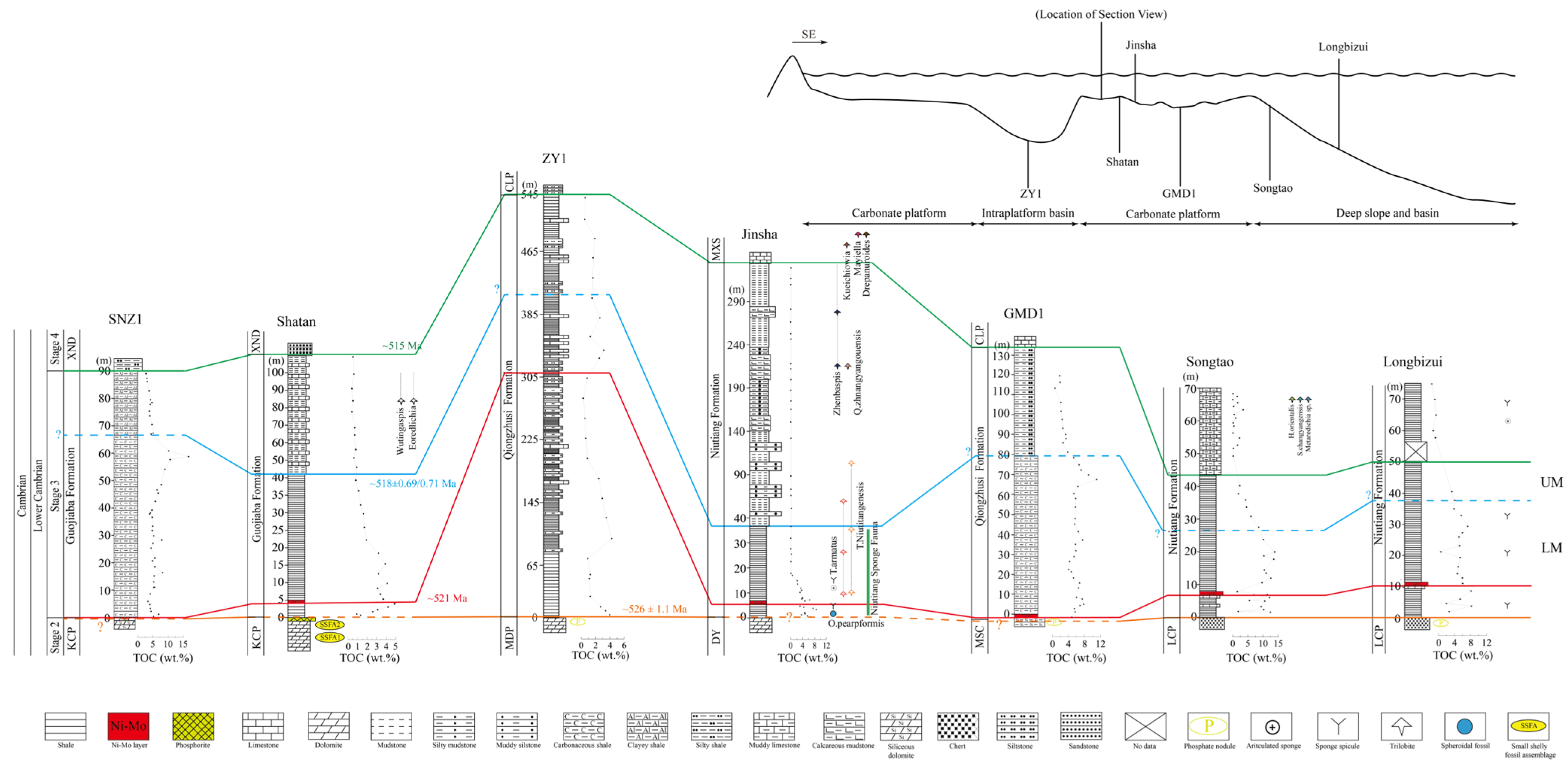Sedimentary Environment and Organic Matter Enrichment Mechanism of the Lower Cambrian Shale in the Northern Margin of the Yangtze Platform
Abstract
1. Introduction
2. Geological Background
3. Methods and Principles
3.1. Methods
3.2. Principles
3.2.1. Paleoclimate Indicator
3.2.2. Terrigenous Aeolian Input Indicator
3.2.3. Redox Conditions Indicator
3.2.4. Hydrodynamic Indicator
3.2.5. Primary Productivity Conditions Indicators
4. Results and Discussion
4.1. Regional Stratigraphic Framwork
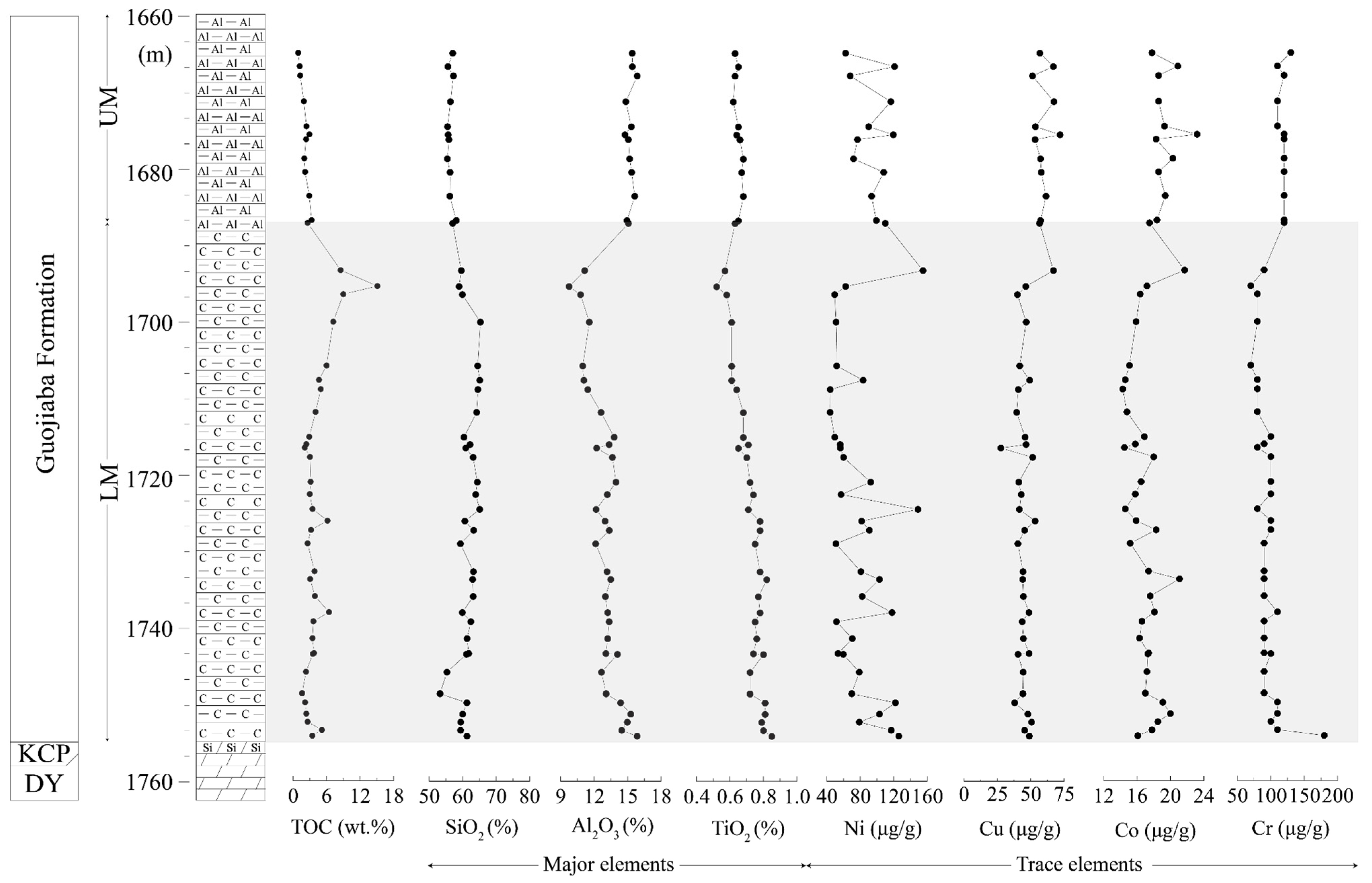
4.2. Paleoclimate and Terrigenous Clastic Input


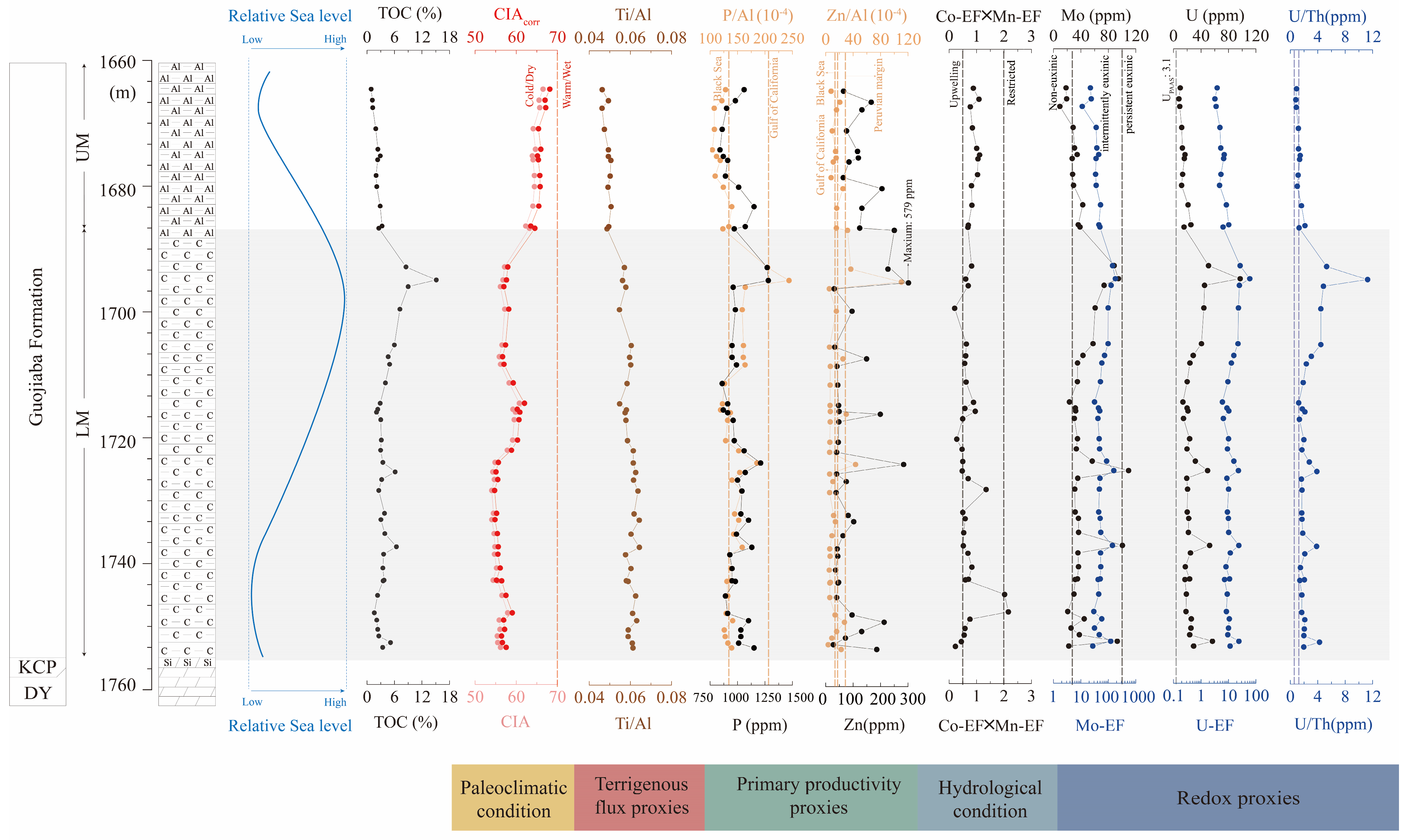
4.3. Redox and Hydrodynamic Conditions
4.4. Primary Productivity Conditions
4.5. OM Enrichment Mechanism in the Northern Margin of the Carbonate Platform
4.6. OM Enrichment Mechanism Across the Yangtze Block
4.6.1. LM Stage Deposition
4.6.2. UM Stage Deposition
4.7. Linkage Between Redox Evolution and the Cambrian Explosion
5. Conclusions
- The Lower Cambrian Guojiaba Formation of the SNZ1 well in the northern margin of the Yangtze Platform primarily consists of black shale, including two numbers with different lithological characteristics. The lower member (LM) is carbonaceous shale, with a TOC content of 1.60–15.11%. The upper member (UM) comprises clay shale, with a TOC content of 0.90–3.29%. This stratum is tentatively ascribed to the Lower Cambrian Stage 3, i.e., deposited during the Early Cambrian Age 3.
- The redox condition of the northern margin of the Yangtze Platform was anoxic during the LM deposition and suboxic–oxic during the UM deposition. Accordingly, the primary productivity transitioned from a moderate–high level to a relatively low level. Paleoclimate evolved from arid–cold to warm–humid conditions, with decreasing input of terrigenous aeolian detritus. The OM enrichment was primarily the preservation control model, and productivity contribution during the late deposition stage of the LM.
- The OM enrichment mechanism constrained by sedimentary environments for the main sedimentary facies across the Yangtze Block was established during the Early Cambrian Age 3. It varied spatiotemporally. From the LM to the UM, the preservation-controlled remained dominant in the intraplatform basin. There was an overall predominance of preservation conditions controlling the carbonate platform, though local regions productivity support existed, while for the deep slope to basin region, the OM enrichment mechanism transitioned from the preservation and productivity jointly controlled to preservation-controlled.
- Although the multi-well analyses provide regional insights, the reconstruction of paleoenvironments based on single-well geochemical profiles cannot fully resolve basin-scale heterogeneities. Future research integrating machine learning and 3D subsurface modeling is essential to overcome this spatial constraint.
Author Contributions
Funding
Data Availability Statement
Acknowledgments
Conflicts of Interest
References
- Fike, D.A.; Grotzinger, J.P.; Pratt, L.M.; Summons, R.E. Oxidation of the Ediacaran Ocean. Nature 2006, 444, 744–747. [Google Scholar] [CrossRef]
- Zhao, G.; Wang, Y.; Huang, B.; Dong, Y.; Li, S.; Zhang, G.; Yu, S. Geological reconstructions of the East Asian blocks: From the breakup of Rodinia to the assembly of Pangea. Earth-Sci. Rev. 2018, 186, 262–286. [Google Scholar] [CrossRef]
- Scott, C.; Lyons, T.W.; Bekker, A.; Shen, Y.; Poulton, S.W.; Chu, X.; Anbar, A.D. Tracing the stepwise oxygenation of the Proterozoic ocean. Nature 2008, 452, 456–459. [Google Scholar] [CrossRef]
- Hoffman, P.F.; Li, Z. A palaeogeographic context for Neoproterozoic glaciation. Palaeogeogr. Palaeoclimatol. Palaeoecol. 2009, 277, 158–172. [Google Scholar] [CrossRef]
- Erwin, D.H.; Laflamme, M.; Tweedt, S.M.; Sperling, E.A.; Pisani, D.; Peterson, K.J. The Cambrian Conundrum: Early Divergence and Later Ecological Success in the Early History of Animals. Science 2011, 334, 1091–1097. [Google Scholar] [CrossRef]
- Awan, R.S.; Liu, C.; Khan, A.; Iltaf, K.H.; Zang, Q.; Wu, Y.; Ali, S.; Gul, M.A. Geochemical Characterization of Organic Rich Black Rocks of the Niutitang Formation to Reconstruct the Paleoenvironmental Settings during Early Cambrian Period from Xiangxi Area, Western Hunan, China. J. Earth Sci. 2023, 34, 1827–1850. [Google Scholar] [CrossRef]
- Demaison, G.J.; Moore, G.T. Anoxic environments and oil source bed genesis. Org. Geochem. 1980, 2, 9–31. [Google Scholar] [CrossRef]
- Pedersen, T.F.; Calvert, S.E. Anoxia vs. Productivity: What Controls the Formation of Organic-Carbon-Rich Sediments and Sedimentary Rocks? AAPG Bull. 1990, 74, 454–466. [Google Scholar] [CrossRef]
- Dimberline, A.J.; Bell, A.; Woodcock, N.H. A laminated hemipelagic facies from the Wenlock and Ludlow of the Welsh Basin. J. Geol. Soc. 1990, 147, 693–701. [Google Scholar] [CrossRef]
- Tyson, R.V. Sedimentation rate, dilution, preservation and total organic carbon: Some results of a modelling study. Org. Geochem. 2001, 32, 333–339. [Google Scholar] [CrossRef]
- Yan, D.; Wang, H.; Fu, Q.; Chen, Z.; He, J.; Gao, Z. Geochemical characteristics in the Longmaxi Formation (Early Silurian) of South China: Implications for organic matter accumulation. Mar. Pet. Geol. 2015, 65, 290–301. [Google Scholar] [CrossRef]
- Schieber, J.; Southard, J.B.; Schimmelmann, A. Lenticular Shale Fabrics Resulting from Intermittent Erosion of Water-Rich Muds—Interpreting the Rock Record in the Light of Recent Flume Experiments. J. Sediment. Res. 2010, 80, 119–128. [Google Scholar] [CrossRef]
- Tan, J.; Wang, Z.; Wang, W.; Hilton, J.; Guo, J.; Wang, X. Depositional Environment and Hydrothermal Controls on OM Enrichment in the Lower Cambrian Niutitang Shale, Southern China. AAPG Bull. 2021, 105, 1329–1356. [Google Scholar] [CrossRef]
- Cao, H.; Wang, Z.; Dong, L.; Xiao, Y.; Hu, L.; Chen, F.; Wei, K.; Chen, C.; Song, Z.; Wu, L. Influence of hydrothermal and upwelling events on organic matter accumulation in the gas-bearing lower Cambrian shales of the middle Yangtze Block, South China. Mar. Pet. Geol. 2023, 155, 106373. [Google Scholar] [CrossRef]
- Gao, P.; Li, S.; Lash, G.G.; Yan, D.; Zhou, Q.; Xiao, X. Stratigraphic framework, redox history, and organic matter accumulation of an Early Cambrian intraplatfrom basin on the Yangtze Platform, South China. Mar. Pet. Geol. 2021, 130, 105095. [Google Scholar] [CrossRef]
- Wang, Y.; Shen, J.; Qiu, Z.; Li, X.; Zhang, L.; Zhang, Q.; Wang, C. Characteristics and environmental significance of concretions in the Lower Cambrian Qiongzhusi Formation in the Middle–Upper Yangtze region, China. J. Nat. Gas Geosci. 2021, 6, 345–361. [Google Scholar] [CrossRef]
- Chang, H.; Chu, X.; Feng, L.; Huang, J.; Chen, Y. Marine redox stratification on the earliest Cambrian (ca. 542–529 Ma) Yangtze Platform. Palaeogeogr. Palaeoclimatol. Palaeoecol. 2018, 504, 75–85. [Google Scholar] [CrossRef]
- Li, J.; Gao, P.; Xiao, X.; Lash, G.G.; Li, S.; Liu, W. Widespread coastal upwelling along the marginal Yangtze Platform (South China) during the early Cambrian: Implications for hyper-enrichment of organic matter. Palaeogeogr. Palaeoclimatol. Palaeoecol. 2024, 656, 112569. [Google Scholar] [CrossRef]
- Chen, D.; Wang, J.; Qing, H.; Yan, D.; Li, R. Hydrothermal venting activities in the Early Cambrian, South China: Petrological, geochronological and stable isotopic constraints. Chem. Geol. 2009, 258, 168–181. [Google Scholar] [CrossRef]
- Wang, N.; Xu, F. Study of Sedimentary Environment of the Niutitang Formation Shale in Xixiang-Zhenba Area, Shaanxi. Miner. Explor. 2019, 10, 1764–1774. (In Chinese) [Google Scholar] [CrossRef]
- Liu, Z.; Yan, D.; Du, X.; Li, S. Organic matter accumulation of the early Cambrian black shales on the flank of Micangshan-Hannan Uplift, northern upper Yangtze Block, South China. J. Pet. Sci. Eng. 2021, 200, 108378. [Google Scholar] [CrossRef]
- Wang, X.; Wo, Y.; Zhang, R.; Li, S. The kinematics of the fold-thrust zones in the western Yangtze Area. Earth Sci. Front. 2010, 17, 200–212. (In Chinese) [Google Scholar]
- Gao, P.; Liu, G.; Jia, C.; Young, A.; Wang, Z.; Wang, T.; Zhang, P.; Wang, D. Redox variations and organic matter accumulation on the Yangtze carbonate platform during Late Ediacaran–Early Cambrian: Constraints from petrology and geochemistry. Palaeogeogr. Palaeoclimatol. Palaeoecol. 2016, 450, 91–110. [Google Scholar] [CrossRef]
- Duan, J.; Mei, Q.; Li, B.; Liang, Z. Sinian-Early Cambrian Tectonic-Sedimentary Evolution in Sichuan Basin. Earth Sci. 2019, 44, 738–755. (In Chinese) [Google Scholar]
- Jiang, G.; Wang, X.; Shi, X.; Xiao, S.; Zhang, S.; Dong, J. The origin of decoupled carbonate and organic carbon isotope signatures in the early Cambrian (ca. 542–520Ma) Yangtze platform. Earth Planet. Sci. Lett. 2012, 317–318, 96–110. [Google Scholar] [CrossRef]
- Liu, S.; Sun, W.; Luo, Z.; Song, J.; Zhong, Y.; Tian, Y.; Peng, H. Xingkai taphrogenesis and petroleum exploration from Upper Sinian to Cambrian Strata in Sichuan Basin, China. J. Chengdu Univ. Technol. (Sci. Technol. Ed.) 2013, 40, 511–520. (In Chinese) [Google Scholar] [CrossRef]
- Li, Z. Meo-Cenozoic Evolution of Dabashan Foreland Basin-Thrust Belt, Central China. Ph.D. Thesis, Chengdu University of Technology, Chengdu, China, 2006. (In Chinese). [Google Scholar]
- Chen, X.; Zhai, G.; Bao, S.; Pang, F.; Wang, J.; Tong, C. Shale gas accumulation and gas-bearing properties of Niutitang formation in well Zhendi 1, Zhenba region of southern Shaanxi province. China Min. Mag. 2018, 27, 101–106. (In Chinese) [Google Scholar]
- Li, H.; Li, F.; Li, X.; Zeng, K.; Gong, Q.l.; Yi, C.h.; Wang, Z.j. Development and collapse of the early Cambrian shallow-water carbonate factories in the Hannan-Micangshan area, South China. Palaeogeogr. Palaeoclimatol. Palaeoecol. 2021, 583, 110665. [Google Scholar] [CrossRef]
- Steiner, M.; Wallis, E.; Erdtmann, B.-D.; Zhao, Y.; Yang, R. Submarine-hydrothermal exhalative ore layers in black shales from South China and associated fossils—Insights into a Lower Cambrian facies and bio-evolution. Palaeogeogr. Palaeoclimatol. Palaeoecol. 2001, 169, 165–191. [Google Scholar] [CrossRef]
- Guo, T.; Chen, X.; Ge, M.; Wang, C.; Bao, S.; Shi, D. Geochemical Characteristics and Genesis of Cambrian Shale Gas in the Southern Margin of Hannan Ancient Uplift. Front. Earth Sci. 2022, 10, 829035. [Google Scholar] [CrossRef]
- Haq, B.U.; Schutter, S.R. A Chronology of Paleozoic Sea-Level Changes. Science 2008, 322, 64–68. [Google Scholar] [CrossRef] [PubMed]
- Meng, G.; Gai, H.; Yang, X.; Gao, P.; Zhou, Q.; Lu, C.; Li, G.; Wang, X.; Cheng, P. Occurrence and maturation transformation of organic and inorganic nitrogen in the Lower Cambrian shelf–slope facies shale: Implications for overmature N2-rich shale reservoirs in Southern China. Mar. Pet. Geol. 2024, 168, 107011. [Google Scholar] [CrossRef]
- Chen, Q.; Li, P.; Wei, X.; Chen, C.; Dang, W.; Nie, H.; Zhang, J. Mineralogy and geochemistry of shale from Shanxi Formation, Southern North China Basin: Implication for organic matter accumulation. Unconv. Resour. 2025, 6, 100151. [Google Scholar] [CrossRef]
- Gao, P.; Xiao, X.; Hu, D.; Lash, G.G.; Liu, R.; Zhang, B.; Zhao, Y. Comparison of silica diagenesis between the lower Cambrian and lower Silurian shale reservoirs in the middle–upper Yangtze platform (southern China). AAPG Bull. 2024, 108, 971–1003. [Google Scholar] [CrossRef]
- Meng, G.; Li, T.; Gai, H.; Xiao, X. Pore Characteristics and Gas Preservation of the Lower Cambrian Shale in a Strongly Deformed Zone, Northern Chongqing, China. Energies 2022, 15, 2956. [Google Scholar] [CrossRef]
- Feng, Y.; Xiao, X.; Gao, P.; Wang, E.; Hu, D.; Liu, R.; Li, G.; Lu, C. Restoration of sedimentary environment and geochemical features of deep marine Longmaxi shale and its significance for shale gas: A case study of the Dingshan area in the Sichuan Basin, South China. Mar. Pet. Geol. 2023, 151, 106186. [Google Scholar] [CrossRef]
- Gao, P.; Xiao, X.; Hu, D.; Lash, G.G.; Liu, R.; Cai, Y.; Wang, Z.; Zhang, B.; Yuan, T.; Liu, S. Effect of silica diagenesis on porosity evolution of deep gas shale reservoir of the Lower Paleozoic Wufeng-Longmaxi formations, Sichuan Basin. Mar. Pet. Geol. 2022, 145, 105873. [Google Scholar] [CrossRef]
- Wang, Q.; Feng, Y.; Gao, P.; Meng, G.; Lu, C.; Fan, Q.; Li, G.; Tan, Y.; Xiao, X. Influence of the sedimentary environment of the Wufeng-Longmaxi shale on organic matter accumulation in the Dingshan area, Sichuan Basin. Front. Earth Sci. 2024, 12, 1457377. [Google Scholar] [CrossRef]
- Nesbitt, H.W.; Young, G.M. Early Proterozoic climates and plate motions inferred from major element chemistry of lutites. Nature 1982, 299, 715–717. [Google Scholar] [CrossRef]
- Mclennan, S.M. Weathering and Global Denudation. J. Geol. 1993, 101, 295–303. [Google Scholar] [CrossRef]
- Yan, D.; Chen, D.; Wang, Q.; Wang, J. Large-scale climatic fluctuations in the latest Ordovician on the Yangtze block, south China. Geology 2010, 38, 599–602. [Google Scholar] [CrossRef]
- Panahi, A.; Young, G.; Rainbird, R. Behavior of major and trace elements (including REE) during Paleoproterozoic pedogenesis and diagenetic alteration of an Archean granite near Ville Marie, Québec, Canada. Geochim. Cosmochim. Acta 2000, 64, 2199–2220. [Google Scholar] [CrossRef]
- Nesbitt, H.W.; Young, G.M. Petrogenesis of sediments in the absence of chemical weathering: Effects of abrasion and sorting on bulk composition and mineralogy. Sedimentology 1996, 43, 341–358. [Google Scholar] [CrossRef]
- Rimmer, S.M.; Thompson, J.A.; Goodnight, S.A.; Robl, T.L. Multiple controls on the preservation of organic matter in Devonian–Mississippian marine black shales: Geochemical and petrographic evidence. Palaeogeogr. Palaeoclimatol. Palaeoecol. 2004, 215, 125–154. [Google Scholar] [CrossRef]
- Canfield, D.E. Factors influencing organic carbon preservation in marine sediments. Chem. Geol. 1994, 114, 315–329. [Google Scholar] [CrossRef]
- Murray, R.W. Chemical criteria to identify the depositional environment of chert: General principles and applications. Sediment. Geol. 1994, 90, 213–232. [Google Scholar] [CrossRef]
- Tada, R.; Iijima, A. Lithostratigraphy and Compositional Variation of Neogene Hemipelagic Sediments in the Japan Sea. Proc. Ocean. Drill. Program Sci. Results 1992, 127/128, 1229–1260. [Google Scholar] [CrossRef]
- Yarincik, K.; Murray, R.; Peterson, L. Climatically sensitive eolian and hemipelagic deposition in the Cariaco Basin, Venezuela, over the past 578,000 years: Results from Al/Ti and K/Al. Paleoceanogr. Paleoclimatol. 2000, 15, 210–228. [Google Scholar] [CrossRef]
- Tribovillard, N.; Algeo, T.J.; Lyons, T.; Riboulleau, A. Trace metals as paleoredox and paleoproductivity proxies: An update. Chem. Geol. 2006, 232, 12–32. [Google Scholar] [CrossRef]
- Wedepohl, K.H. Environmental influences on the chemical composition of shales and clays. Phys. Chem. Earth 1971, 8, 307–333. [Google Scholar] [CrossRef]
- Mclennan, S.M. Relationships between the trace element composition of sedimentary rocks and upper continental crust. Geochem. Geophys. Geosyst. 2001, 2, 2000GC000109. [Google Scholar] [CrossRef]
- Tribovillard, N.; Algeo, T.J.; Baudin, F.; Riboulleau, A. Analysis of marine environmental conditions based onmolybdenum–uranium covariation—Applications to Mesozoic paleoceanography. Chem. Geol. 2012, 324–325, 46–58. [Google Scholar] [CrossRef]
- Sweere, T.; Van Den Boorn, S.; Dickson, A.J.; Reichart, G.J. Definition of new trace-metal proxies for the controls on organic matter enrichment in marine sediments based on Mn, Co, Mo and Cd concentrations. Chem. Geol. 2016, 441, 235–245. [Google Scholar] [CrossRef]
- Wang, Y.; Xu, S.; Hao, F.; Lu, Y.; Shu, Z.; Yan, D.; Lu, Y. Geochemical and petrographic characteristics of Wufeng-Longmaxi shales, Jiaoshiba area, southwest China: Implications for organic matter differential accumulation. Mar. Pet. Geol. 2019, 102, 138–154. [Google Scholar] [CrossRef]
- Xiao, W.; Cao, J.; Wang, X.; Xiao, D.; Shi, C.; Zhang, S. Marine chemical structure during the Cambrian explosion. Earth-Sci. Rev. 2024, 251, 104716. [Google Scholar] [CrossRef]
- Zhao, B.; Long, X.; Chang, C. Early Cambrian sedimentary rocks in South China: A link between oceanic oxygenation and biological explosion. Earth-Sci. Rev. 2024, 250, 104708. [Google Scholar] [CrossRef]
- Zhang, Y.; Zhang, T.; Huang, D.; Shao, D.; Luo, H. Geochemical and paleontological evidence of early Cambrian dynamic ocean oxygenation and its implications for organic matter accumulation in mudrocks at the Three Gorges area, South China. Mar. Pet. Geol. 2022, 146, 105958. [Google Scholar] [CrossRef]
- Xu, L.; Bernd, L.; Mao, J.; Qu, W.; Du, A. Re-Os Age of Polymetallic Ni-Mo-PGE-Au Mineralization in Early Cambrian Black Shales of South China—A Reassessment. Econ. Geol. 2011, 106, 511–522. [Google Scholar] [CrossRef]
- Na, L.; Kiessling, W. Diversity partitioning during the Cambrian radiation. Proc. Natl. Acad. Sci. USA 2015, 112, 4702–4706. [Google Scholar] [CrossRef]
- Sichuan Bureau of Geological Exploration. Geological Survey Report of the Zhenba Quadrangle (1:200,000); Sichuan Bureau of Geological Exploration: Chengdu, China, 1970. (In Chinese) [Google Scholar]
- Yuan, J.; Zhao, W. Subdivision and Correlation of Lower Cambrian in Southwest China, with a Discussion of the Age of Early Cambrian Series Biota. Acta Palaeontol. Sin. 1999, 38, 116–131. (In Chinese) [Google Scholar] [CrossRef]
- Jin, C.; Li, C.; Algeo, T.J.; Planavsky, N.J.; Cui, H.; Yang, X.; Zhao, Y.; Zhang, X.; Xie, S. A highly redox-heterogeneous ocean in South China during the early Cambrian (∼529–514 Ma): Implications for biota-environment co-evolution. Earth Planet. Sci. Lett. 2016, 441, 38–51. [Google Scholar] [CrossRef]
- Yang, X.; Zhao, Y.; Wu, W.; Zheng, H.; Zhu, Y. Phragmodictya jinshaensis sp. nov., a hexactinellid dictyosponge from the Cambrian of Jinsha, south China. GFF 2014, 136, 309–313. [Google Scholar] [CrossRef]
- Goldberg, T.; Strauss, H.; Guo, Q.; Liu, C. Reconstructing marine redox conditions for the Early Cambrian Yangtze Platform: Evidence from biogenic sulphur and organic carbon isotopes. Palaeogeogr. Palaeoclimatol. Palaeoecol. 2007, 254, 175–193. [Google Scholar] [CrossRef]
- Guo, Q.; Strauss, H.; Liu, C.; Goldberg, T.; Zhu, M.; Pi, D.; Heubeck, C.; Vernhet, E.; Yang, X.; Fu, P. Carbon isotopic evolution of the terminal Neoproterozoic and early Cambrian: Evidence from the Yangtze Platform, South China. Palaeogeogr. Palaeoclimatol. Palaeoecol. 2007, 254, 140–157. [Google Scholar] [CrossRef]
- Wu, Y.; Tian, H.; Gong, D.; Li, T.; Zhou, Q. Paleo-environmental variation and its control on organic matter enrichment of black shales from shallow shelf to slope regions on the Upper Yangtze Platform during Cambrian Stage 3. Palaeogeogr. Palaeoclimatol. Palaeoecol. 2020, 545, 109653. [Google Scholar] [CrossRef]
- Yang, A.; Zhu, M.; Zhang, J.; Li, G. Early Cambrian eodiscoid trilobites of the Yangtze Platform and their stratigraphic implications. Prog. Nat. Sci. 2003, 13, 861–866. [Google Scholar] [CrossRef]
- Wang, J.; Chen, D.; Yan, D.; Wei, H.; Xiang, L. Evolution from an anoxic to oxic deep ocean during the Ediacaran–Cambrian transition and implications for bioradiation. Chem. Geol. 2012, 306–307, 129–138. [Google Scholar] [CrossRef]
- Och, L.M.; Cremonese, L.; Shields-Zhou, G.A.; Poulton, S.W.; Struck, U.; Ling, H.-F.; Li, D.; Chen, X.; Manning, C.J.; Thirlwall, M.; et al. Palaeoceanographic controls on spatial redox distribution over the Yangtze Platform during the Ediacaran–Cambrian transition. Sedimentology 2016, 63, 378–410. [Google Scholar] [CrossRef]
- Hayashi, K.-I.; Fujisawa, H.; Holland, H.D.; Ohmoto, H. Geochemistry of ∼1.9 Ga sedimentary rocks from northeastern Labrador, Canada. Geochim. Cosmochim. Acta 1997, 61, 4115–4137. [Google Scholar] [CrossRef]
- Xiao, L.; Zhang, H.; Ni, P.Z.; Xiang, H.; Liu, X. LA-ICP-MS U–Pb zircon geochronology of early Neoproterozoic mafic-intermediat intrusions from NW margin of the Yangtze Block, South China: Implication for tectonic evolution. Precambrian Res. 2007, 154, 221–235. [Google Scholar] [CrossRef]
- Wang, X.; Li, X.; Li, W.; Li, Z.; Liu, Y.; Yang, Y.; Liang, X.; Tu, X. The Bikou basalts in the northwestern Yangtze block, South China: Remnants of 820–810 Ma continental flood basalts? GSA Bull. 2008, 120, 1478–1492. [Google Scholar] [CrossRef]
- Zhao, J.; Zhou, M. Neoproterozoic adakitic plutons in the northern margin of the Yangtze Block, China: Partial melting of a thickened lower crust and implications for secular crustal evolution. Lithos 2008, 104, 231–248. [Google Scholar] [CrossRef]
- Zhou, M.; Yan, D.; Wang, C.; Qi, L.; Kennedy, A. Subduction-related origin of the 750 Ma Xuelongbao adakitic complex (Sichuan Province, China): Implications for the tectonic setting of the giant Neoproterozoic magmatic event in South China. Earth Planet. Sci. Lett. 2006, 248, 286–300. [Google Scholar] [CrossRef]
- Jia, X. Analysis of Provenance and Basin Type of the Cambrian in the Micangshan Area. Master’s Thesis, China University of Geosciences (Beijing), Beijing, China, 2018. (In Chinese). [Google Scholar]
- Zhang, G.; Chen, D.; Huang, K.; Liu, M.; Huang, T.; Yeasmin, R.; Fu, Y. Dramatic attenuation of continental weathering during the Ediacaran-Cambrian transition: Implications for the climatic-oceanic-biological co-evolution. Glob. Planet. Change 2021, 203, 103518. [Google Scholar] [CrossRef]
- Rieu, R.; Allen, P.A.; Plötze, M.; Pettke, T. Climatic cycles during a Neoproterozoic “snowball” glacial epoch. Geology 2007, 35, 299–302. [Google Scholar] [CrossRef]
- Condie, K.C. Chemical composition and evolution of the upper continental crust: Contrasting results from surface samples and shales. Chem. Geol. 1993, 104, 1–37. [Google Scholar] [CrossRef]
- Hessler, A.M.; Lowe, D.R. Weathering and sediment generation in the Archean: An integrated study of the evolution of siliciclastic sedimentary rocks of the 3.2Ga Moodies Group, Barberton Greenstone Belt, South Africa. Precambrian Res. 2006, 151, 185–210. [Google Scholar] [CrossRef]
- Zhang, S.; Li, H.; Jiang, G.; Evans, D.A.D.; Dong, J.; Wu, H.; Yang, T.; Liu, P.; Xiao, Q. New paleomagnetic results from the Ediacaran Doushantuo Formation in South China and their paleogeographic implications. Precambrian Res. 2015, 259, 130–142. [Google Scholar] [CrossRef]
- Gao, P.; He, Z.; Lash, G.G.; Zhou, Q.; Xiao, X. Controls on silica enrichment of lower cambrian organic-rich shale deposits. Mar. Pet. Geol. 2021, 130, 105126. [Google Scholar] [CrossRef]
- Zhang, J.; Fan, T.; Algeo, T.J.; Li, Y.; Zhang, J. Paleo-marine environments of the Early Cambrian Yangtze Platform. Palaeogeogr. Palaeoclimatol. Palaeoecol. 2016, 443, 66–79. [Google Scholar] [CrossRef]
- Cullers, R.L.; Podkovyrov, V.N. Geochemistry of the Mesoproterozoic Lakhanda shales in southeastern Yakutia, Russia: Implications for mineralogical and provenance control, and recycling. Precambrian Res. 2000, 104, 77–93. [Google Scholar] [CrossRef]
- Mclennan, S.M.; Hemming, S.; Mcdaniel, D.K.; Hanson, G.N. Geochemical approaches to sedimentation, provenance, and tectonics. In Processes Controlling the Composition of Clastic Sediments; Johnsson, M.J., Basu, A., Eds.; Geological Society of America: Boulder, CO, USA, 1993. [Google Scholar] [CrossRef]
- Algeo, T.J. Can marine anoxic events draw down the trace element inventory of seawater? Geology 2004, 32, 1057–1060. [Google Scholar] [CrossRef]
- Zhao, Y.; Gao, P.; Zhou, Q.; Meng, G.; Liu, W.; Xing, Y.; Xiao, X. Controls on Graphitization and Nanopore Characteristics of Organic Matter in Marine Overmature Shale. Nat. Resour. Res. 2025, 34, 1527–1556. [Google Scholar] [CrossRef]
- Algeo, T.J.; Tribovillard, N. Environmental analysis of paleoceanographic systems based on molybdenum–uranium covariation. Chem. Geol. 2009, 268, 211–225. [Google Scholar] [CrossRef]
- Taylor, F.W.; Mann, P.; Valastro, S.; Burke, K. Stratigraphy and Radiocarbon Chronology of a Subaerially Exposed Holocene Coral Reef, Dominican Republic. J. Geol. 1985, 93, 311–332. [Google Scholar] [CrossRef]
- Scott, C.; Lyons, T.W. Contrasting molybdenum cycling and isotopic properties in euxinic versus non-euxinic sediments and sedimentary rocks: Refining the paleoproxies. Chem. Geol. 2012, 324–325, 19–27. [Google Scholar] [CrossRef]
- Lyons, T.W.; Werne, J.P.; Hollander, D.J.; Murray, R.W. Contrasting sulfur geochemistry and Fe/Al and Mo/Al ratios across the last oxic-to-anoxic transition in the Cariaco Basin, Venezuela. Chem. Geol. 2003, 195, 131–157. [Google Scholar] [CrossRef]
- Böning, P.; Brumsack, H.-J.; Böttcher, M.E.; Schnetger, B.; Kriete, C.; Kallmeyer, J.; Borchers, S.L. Geochemistry of Peruvian near-surface sediments. Geochim. Cosmochim. Acta 2004, 68, 4429–4451. [Google Scholar] [CrossRef]
- Canfield, D.E. The early history of atmospheric oxygen: Homage to Robert M. Garrels. Annu. Rev. Earth Planet. Sci. 2005, 33, 1–36. [Google Scholar] [CrossRef]
- Algeo, T.J.; Lyons, T.W. Mo–total organic carbon covariation in modern anoxic marine environments: Implications for analysis of paleoredox and paleohydrographic conditions. Paleoceanogr. Paleoclimatol. 2006, 21, 1112. [Google Scholar] [CrossRef]
- Liu, Z.; Algeo, T.J.; Guo, X.; Fan, J.; Du, X.; Lu, Y. Paleo-environmental cyclicity in the Early Silurian Yangtze Sea (South China): Tectonic or glacio-eustatic control? Palaeogeogr. Palaeoclimatol. Palaeoecol. 2017, 466, 59–76. [Google Scholar] [CrossRef]
- Brumsack, H.-J. Geochemistry of recent TOC-rich sediments from the Gulf of California and the Black Sea. Geol. Rundsch. 1989, 78, 851–882. [Google Scholar] [CrossRef]
- Cheng, M.; Zhang, Z.; Jin, C.; Wei, W.; Wang, H.; Algeo, T.J.; Li, C. Salinity variation and hydrographic dynamics in the early Cambrian Nanhua Basin (South China). Sci. China Earth Sci. 2023, 66, 1268–1278. [Google Scholar] [CrossRef]
- Algeo, T.J.; Heckel, P.H.; Maynard, J.B.; Blakey, R.C.; Rowe, H.D. Modern and ancient epeiric seas and the super-estuarine circulation model of marine anoxia. In Dynamics of Epeiric Seas: Sedimentological, Paleontological and Geochemical Perspectives; Geological Association of Canada: St. John’s, NL, Canada; pp. 7–38.
- Robbins, L.J.; Lalonde, S.V.; Planavsky, N.J.; Partin, C.A.; Reinhard, C.T.; Kendall, B.; Scott, C.; Hardisty, D.S.; Gill, B.C.; Alessi, D.S.; et al. Trace elements at the intersection of marine biological and geochemical evolution. Earth-Sci. Rev. 2016, 163, 323–348. [Google Scholar] [CrossRef]
- Morse, J.W.; Luther, G.W. Chemical influences on trace metal-sulfide interactions in anoxic sediments. Geochim. Cosmochim. Acta 1999, 63, 3373–3378. [Google Scholar] [CrossRef]
- Algeo, T.J.; Ingall, E. Sedimentary Corg:P ratios, paleocean ventilation, and Phanerozoic atmospheric pO2. Palaeogeogr. Palaeoclimatol. Palaeoecol. 2007, 256, 130–155. [Google Scholar] [CrossRef]
- Niu, X.; Liu, Y.; Yan, D.; Hu, M.; Liu, Z.; Wei, X.; Zuo, M. Constraints on the Organic Matter Accumulation of Lower Cambrian Niutitang Shales in the Middle Yangtze Region, South China. Lithos. 2021, 2021, 6684574. [Google Scholar] [CrossRef]
- Zhang, B.; Yao, S.; Hu, W.; Ding, H.; Liu, B.; Ren, Y. Development of a high-productivity and anoxic-euxinic condition during the late Guadalupian in the Lower Yangtze region: Implications for the mid-Capitanian extinction event. Palaeogeogr. Palaeoclimatol. Palaeoecol. 2019, 531, 108630. [Google Scholar] [CrossRef]
- Abbaszadeh Shahri, A.; Shan, C.; Larsson, S. A Novel Approach to Uncertainty Quantification in Groundwater Table Modeling by Automated Predictive Deep Learning. Nat. Resour. Res. 2022, 31, 1351–1373. [Google Scholar] [CrossRef]
- Abbaszadeh Shahri, A.; Spross, J.; Johansson, F.; Larsson, S. Landslide susceptibility hazard map in southwest Sweden using artificial neural network. CATENA 2019, 183, 104225. [Google Scholar] [CrossRef]
- Jin, C.; Li, C.; Algeo, T.J.; Wu, S.; Cheng, M.; Zhang, Z.; Shi, W. Controls on organic matter accumulation on the early-Cambrian western Yangtze Platform, South China. Mar. Pet. Geol. 2020, 111, 75–87. [Google Scholar] [CrossRef]
- Zhang, B.; Yao, S.; Hu, W.; Han, Z.; Liao, Z.; Liu, B.; Mu, L. Middle Permian palaeoclimatic-palaeoceanographic evolution and its controls on organic matter accumulation in the Lower Yangtze upwelling region. Int. J. Coal Geol. 2022, 264, 104132. [Google Scholar] [CrossRef]
- Berner, R.A.; Petsch, S.T.; Lake, J.A.; Beerling, D.J.; Popp, B.N.; Lane, R.S.; Laws, E.; Westley, M.B.; Cassar, N.; Woodward, F.I.; et al. Isotope fractionation and atmospheric oxygen: Implications for phanerozoic O(2) evolution. Science 2000, 287, 1630–1633. [Google Scholar] [CrossRef]
- Shao, D.; Zhang, T.; Milliken, K.L.; Zhou, S.; Li, J.; Li, Y.; Zhou, Q. Evolution of a microfracture network induced by hydrocarbon generation during experimental maturation of organic-rich lacustrine shale. Geology 2025. [Google Scholar] [CrossRef]
- Huang, C.; Chen, S. Effects of Ductility of Organic-Rich Shale on Hydraulic Fracturing: A Fully Coupled Extended-Finite-Element-Method Analysis Using a Modified Cohesive Zone Model. SPE J. 2021, 26, 591–609. [Google Scholar] [CrossRef]
- Zhang, Q.; Liu, E.; Pan, S.; Wang, H.; Jing, Z.; Zhao, Z.; Zhu, R. Multiple Controls on Organic Matter Accumulation in the Intraplatform Basin of the Early Cambrian Yangtze Platform, South China. J. Mar. Sci. Eng. 2023, 11, 1907. [Google Scholar] [CrossRef]
- Luo, H.; Zhang, T.; Yan, J.P.; Gong, J. Rare earth elements and yttrium (REY) distribution pattern of lower Cambrian organic-rich shale in Yichang area, Western Hubei Province, South China, and source of carbonate minerals. Appl. Geochem. 2022, 136, 105173. [Google Scholar] [CrossRef]
- Chen, L.; Zhang, B.; Chen, X.; Jiang, S.; Zhang, G.; Lin, W.b.; Chen, P.; Liu, Z. Depositional environment and organic matter accumulation of the Lower Cambrian Shuijingtuo Formation in the middle Yangtze area, China. J. Pet. Sci. Eng. 2022, 208, 109339. [Google Scholar] [CrossRef]
- Liu, Z.; Yan, D.; Yuan, D.; Niu, X.; Fu, H. Multiple controls on the organic matter accumulation in early Cambrian marine black shales, middle Yangtze Block, South China. J. Nat. Gas. Sci. Eng. 2022, 100, 104454. [Google Scholar] [CrossRef]
- Ye, Y.; Wang, H.; Wang, X.; Zhai, L.; Wu, C.; Canfield, D.E.; Zhang, S. Tracking the evolution of seawater Mo isotopes through the Ediacaran–Cambrian transition. Precambrian Res. 2020, 350, 105929. [Google Scholar] [CrossRef]
- Wu, Y.; Tian, H.; Jia, W.; Li, J.; Li, T.; Zhou, Q.; Xie, L.; Peng, P. Nitrogen isotope evidence for stratified ocean redox structure during late Ediacaran to Cambrian Age 3 in the Yangtze Block of South China. Chem. Geol. 2022, 589, 120679. [Google Scholar] [CrossRef]
- Chen, Z.; Wang, G.; Jin, C. Marine redox variation and hydrographic restriction in the early Cambrian Nanhua Basin, South China. Palaeogeogr. Palaeoclimatol. Palaeoecol. 2022, 607, 111263. [Google Scholar] [CrossRef]
- Yuan, Y. Geochemical Characteristics of Black Rock Series and Paleoceanic Implications of Ediacaran-Cambrian Transition Period, South China. Ph.D. Thesis, The Institute of Geology and Geophysics, China Academy of Sciences, Beijing, China, 2014. (In Chinese). [Google Scholar]
- Liu, W.; Gao, P.; Xiao, X.; Zhao, Y.; Xing, Y.; Li, J. Variable depositional environments and organic matter enrichment of Early Cambrian shales in the Middle Yangtze region, South China. J. Asian Earth Sci. 2024, 259, 105874. [Google Scholar] [CrossRef]
- Johnston, D.T.; Poulton, S.W.; Dehler, C.; Porter, S.; Husson, J.; Canfield, D.E.; Knoll, A.H. An emerging picture of Neoproterozoic ocean chemistry: Insights from the Chuar Group, Grand Canyon, USA. Earth Planet. Sci. Lett. 2010, 290, 64–73. [Google Scholar] [CrossRef]
- Huang, T.; Chen, D.; Fu, Y.; Yeasmin, R.; Guo, C. Development and evolution of a euxinic wedge on the ferruginous outer shelf of the early Cambrian Yangtze sea. Chem. Geol. 2019, 524, 259–271. [Google Scholar] [CrossRef]
- Wei, G.; Planavsky, N.J.; Tarhan, L.G.; He, T.; Wang, D.; Shields, G.A.; Wei, W.; Ling, H.-F. Highly dynamic marine redox state through the Cambrian explosion highlighted by authigenic δ238U records. Earth Planet. Sci. Lett. 2020, 544, 116361. [Google Scholar] [CrossRef]
- Liu, Z.; Dickson, A.J.; Sun, H.; Wu, Y.; Qiu, Z.; Tian, H. Cadmium isotope evidence for near-modern bio-productivity in the early Cambrian ocean. Chem. Geol. 2024, 663, 122275. [Google Scholar] [CrossRef]
- Guo, Q.; Deng, Y.; Hippler, D.; Franz, G.; Zhang, J. REE and trace element patterns from organic-rich rocks of the Ediacaran–Cambrian transitional interval. Gondwana Res. 2016, 36, 94–106. [Google Scholar] [CrossRef]
- Yeasmin, R.; Chen, D.; Fu, Y.; Wang, J.; Guo, Z.; Guo, C. Climatic-oceanic forcing on the organic accumulation across the shelf during the Early Cambrian (Age 2 through 3) in the mid-upper Yangtze Block, NE Guizhou, South China. J. Asian Earth Sci. 2017, 134, 365–386. [Google Scholar] [CrossRef]
- Xiang, L.; Schoepfer, S.D.; Shen, S.; Cao, C.; Zhang, H. Evolution of oceanic molybdenum and uranium reservoir size around the Ediacaran–Cambrian transition: Evidence from western Zhejiang, South China. Earth Planet. Sci. Lett. 2017, 464, 84–94. [Google Scholar] [CrossRef]
- Fu, D.; Tong, G.; Dai, T.; Liu, W.; Yang, Y.; Zhang, Y.; Cui, L.; Li, L.; Yun, H.; Wu, Y.; et al. The Qingjiang biota—A Burgess Shale–type fossil Lagerstätte from the early Cambrian of South China. Science 2019, 363, 1338–1342. [Google Scholar] [CrossRef] [PubMed]
- Yang, C.; Li, X.; Zhu, M.; Condon, D.J.; Chen, J. Geochronological constraint on the Cambrian Chengjiang biota, South China. J. Geol. Soc. 2018, 175, 659–666. [Google Scholar] [CrossRef]
- Mills, D.B.; Ward, L.M.; Jones, C.; Sweeten, B.; Forth, M.; Treusch, A.H.; Canfield, D.E. Oxygen requirements of the earliest animals. Proc. Natl. Acad. Sci. USA 2014, 111, 4168–4172. [Google Scholar] [CrossRef]
- Sperling, E.A.; Frieder, C.A.; Raman, A.V.; Girguis, P.R.; Levin, L.A.; Knoll, A.H. Oxygen, ecology, and the Cambrian radiation of animals. Proc. Natl. Acad. Sci. USA 2013, 110, 13446–13451. [Google Scholar] [CrossRef]
- Smith, M.P.; Harper, D.A.T. Causes of the Cambrian Explosion. Science 2013, 341, 1355–1356. [Google Scholar] [CrossRef]
- Lenton, T.M.; Boyle, R.A.; Poulton, S.W.; Shields-Zhou, G.A.; Butterfield, N.J. Co-evolution of eukaryotes and ocean oxygenation in the Neoproterozoic era. Nat. Geosci. 2014, 7, 257–265. [Google Scholar] [CrossRef]
- Mills, D.B.; Francis, W.R.; Vargas, S.; Larsen, M.; Elemans, C.P.H.; Canfield, D.E.; Wörheide, G. The last common ancestor of animals lacked the HIF pathway and respired in low-oxygen environments. eLife 2018, 7, e31176. [Google Scholar] [CrossRef] [PubMed]
- Steiner, M.; Zhu, M.; Zhao, Y.; Erdtmann, B.-D. Lower Cambrian Burgess Shale-type fossil associations of South China. Palaeogeogr. Palaeoclimatol. Palaeoecol. 2005, 220, 129–152. [Google Scholar] [CrossRef]
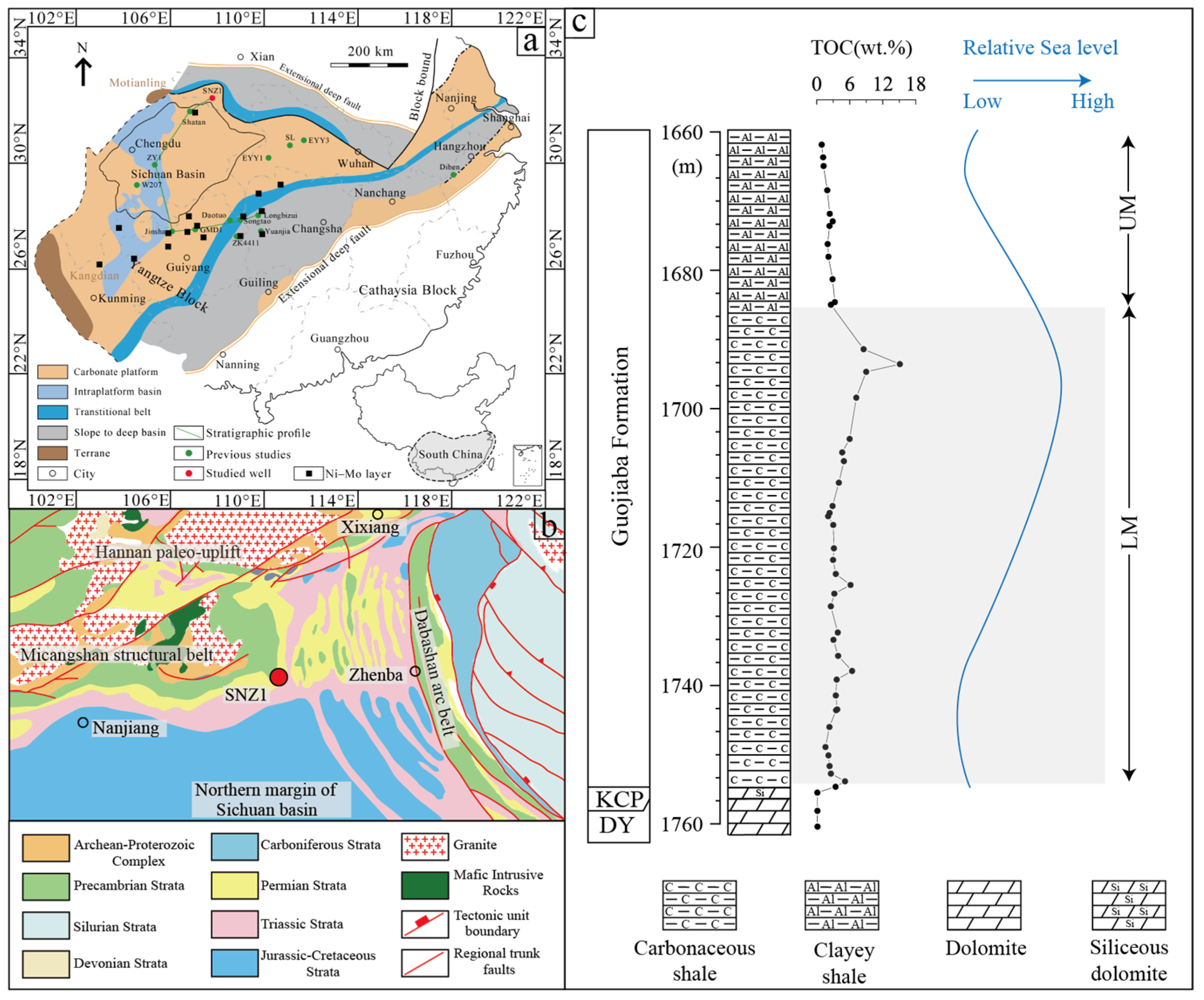


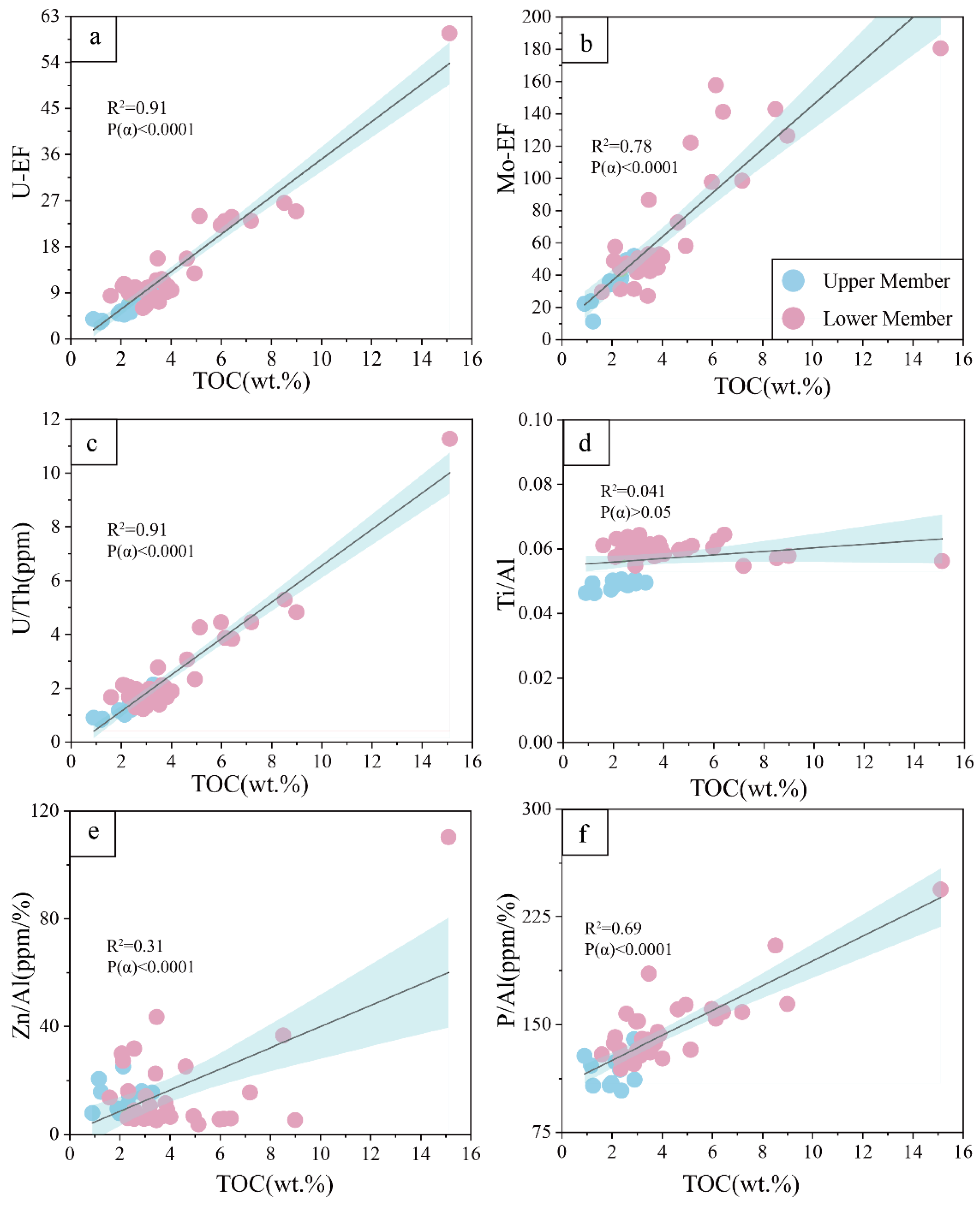

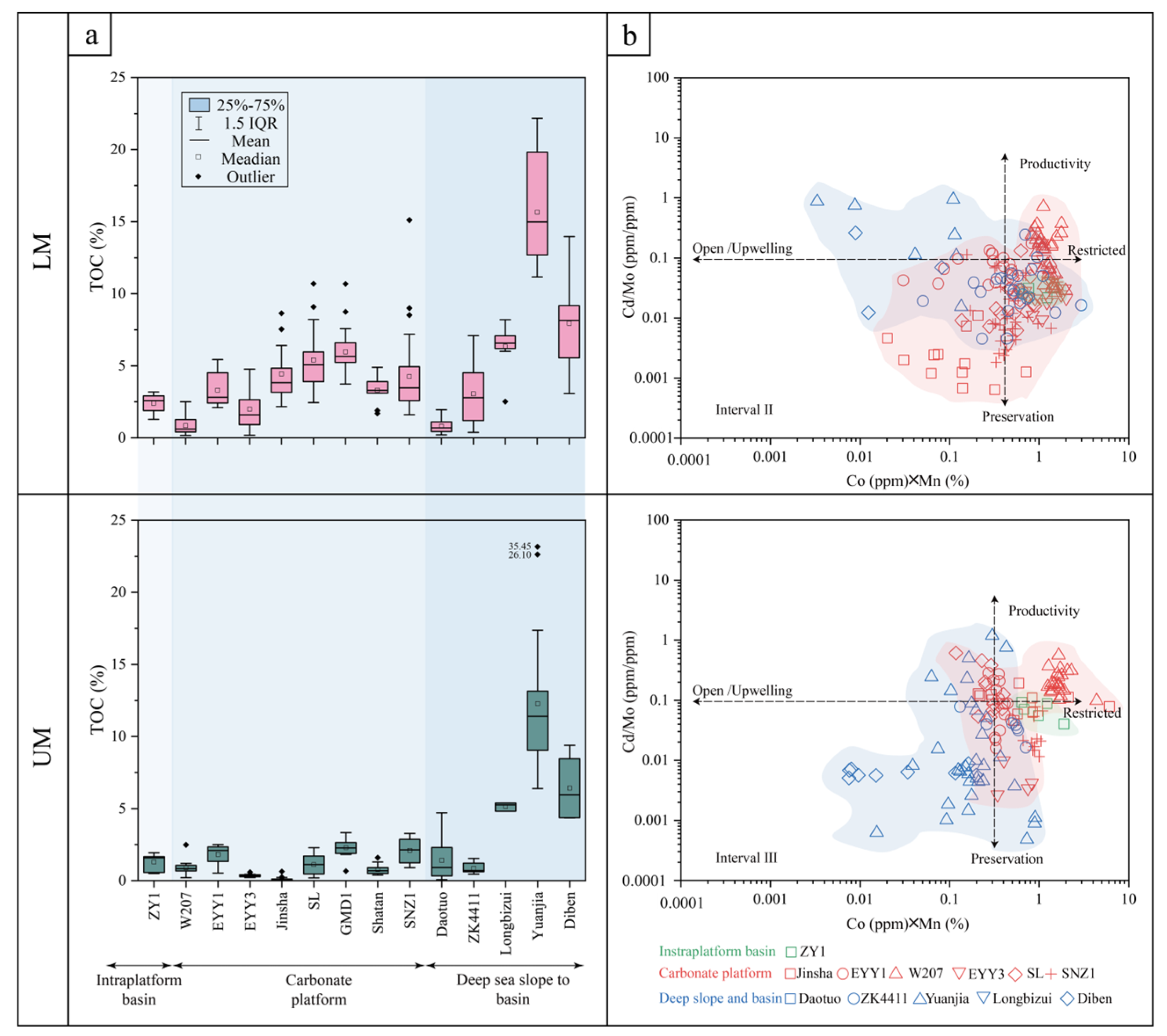
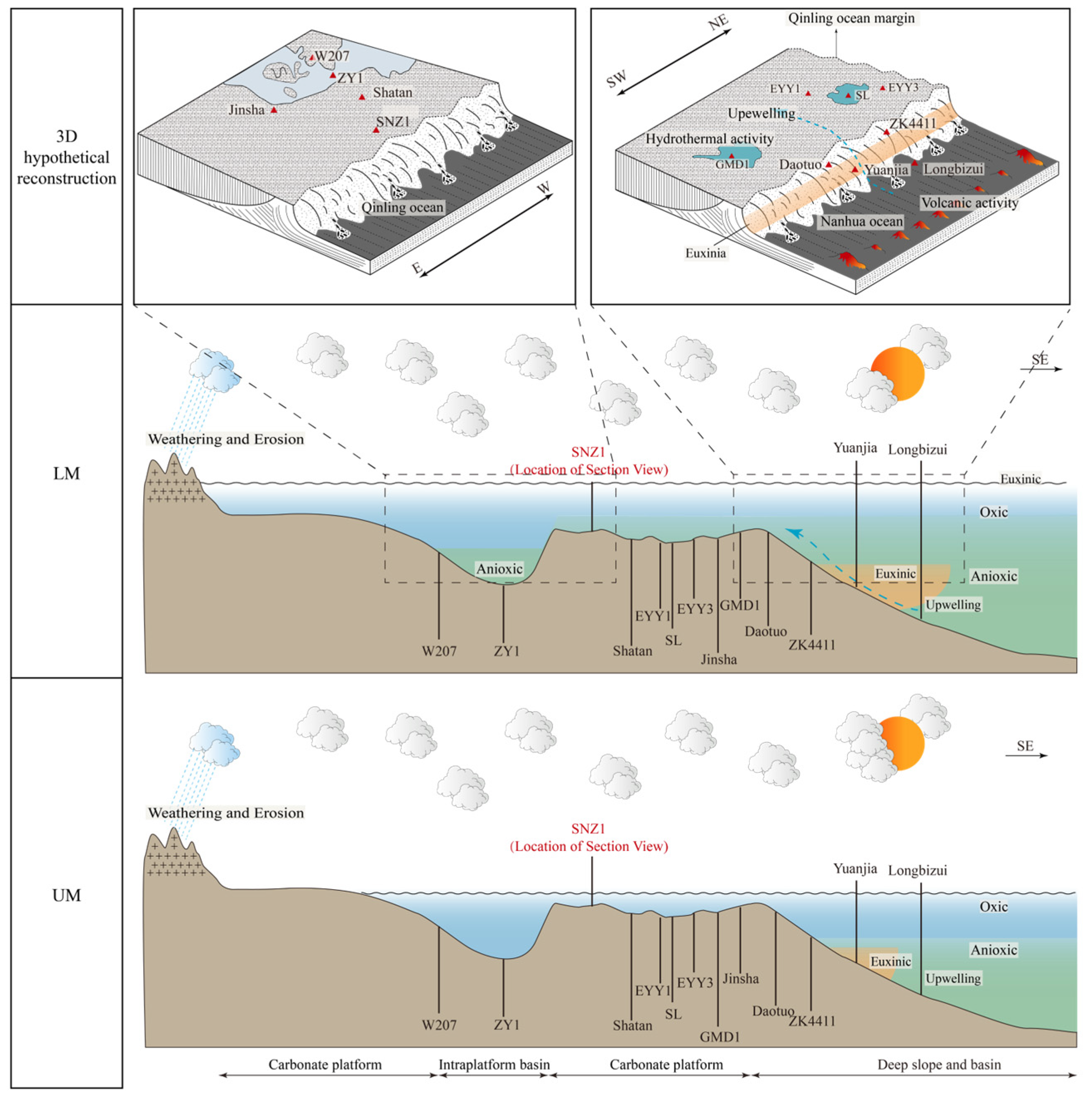
Disclaimer/Publisher’s Note: The statements, opinions and data contained in all publications are solely those of the individual author(s) and contributor(s) and not of MDPI and/or the editor(s). MDPI and/or the editor(s) disclaim responsibility for any injury to people or property resulting from any ideas, methods, instructions or products referred to in the content. |
© 2025 by the authors. Licensee MDPI, Basel, Switzerland. This article is an open access article distributed under the terms and conditions of the Creative Commons Attribution (CC BY) license (https://creativecommons.org/licenses/by/4.0/).
Share and Cite
Tan, Y.; Meng, G.; Feng, Y.; Liu, W.; Wang, Q.; Gao, P.; Xiao, X. Sedimentary Environment and Organic Matter Enrichment Mechanism of the Lower Cambrian Shale in the Northern Margin of the Yangtze Platform. J. Mar. Sci. Eng. 2025, 13, 1175. https://doi.org/10.3390/jmse13061175
Tan Y, Meng G, Feng Y, Liu W, Wang Q, Gao P, Xiao X. Sedimentary Environment and Organic Matter Enrichment Mechanism of the Lower Cambrian Shale in the Northern Margin of the Yangtze Platform. Journal of Marine Science and Engineering. 2025; 13(6):1175. https://doi.org/10.3390/jmse13061175
Chicago/Turabian StyleTan, Yineng, Guangming Meng, Yue Feng, Wei Liu, Qiang Wang, Ping Gao, and Xianming Xiao. 2025. "Sedimentary Environment and Organic Matter Enrichment Mechanism of the Lower Cambrian Shale in the Northern Margin of the Yangtze Platform" Journal of Marine Science and Engineering 13, no. 6: 1175. https://doi.org/10.3390/jmse13061175
APA StyleTan, Y., Meng, G., Feng, Y., Liu, W., Wang, Q., Gao, P., & Xiao, X. (2025). Sedimentary Environment and Organic Matter Enrichment Mechanism of the Lower Cambrian Shale in the Northern Margin of the Yangtze Platform. Journal of Marine Science and Engineering, 13(6), 1175. https://doi.org/10.3390/jmse13061175







